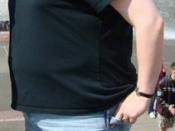The intent of this paper is to give an analysis of one theory of motivation. The chosen theory is the motivational principle of instinct. Before we can begin to discuss the motivational theory of instinct and give an example of an observed experience, it is necessary to go back to one of the original and major theories of motivation; Hull's theory of Drive.
Hull first conceived all motivation as coming from a biological imbalance or needs. The organism was thrown into motion when it needed something that was not present. For Hull motivation (i.e., drive) had a purely physiological basis and bodily need was the ultimate basis of motivation. (Reeve, 2001) Hunger is the need for more energy. Thirst is the need for more water. Motivation, to Hull, was aimed at making up or erasing a deficiency or lack of something in the organism. In Hull's theory, drive was the energy that powered behavior.
But drive was unpleasant. Drive was an uncomfortable state resulting from a biological need, so drive was something the animal tried to get rid of. Therefore the animal would repeat any behavior that reduced the drive, if the same need occurred again. Therefore Hull's theory was called a drive-reduction theory of motivation. He theorized that the probability that a particular stimulus would lead to a particular response (the "excitation potential") using the formula: sEr = sHr X (D X K X J X V).
The variable sEr is the strength of behavior; sHr is habit strength; D is the amount of drive or biological deprivation; K is the size of the goal; J is the delay before the goal is allowed to be pursued and V is the intensity of the stimulus that set off the behavior. (Reeve, 2001).
Many researchers responded...


